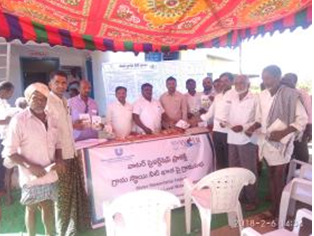– K.Bhavana Rao, Divya Nazareth, Jyothirmayee Kandula
Renewable surface water and groundwater resources in most dry subtropical regions are projected to reduce due to the increasing competition for water among sectors; agriculture, industry, urban and rural .For the rural poor inhabiting the developing regions across the world, it means water resources will become scarce. At the same time, when there are stronger livelihood drivers pushing farming communities to produce crops and /or animal products that are water intensive coupled with the pressure to earn more for a better quality of life – adapting to water scare conditions is a challenge.
Post-watershed development intervention activities in the clusters of villages in Rangareddy and Nagaurkurnool districts in Telangana, WOTR shifted attention towards climate compatible agriculture-based livelihoods. This necessarily requires water management and ‘water budgeting’ at a village level. This blogpost describes the need and the objectives of the water budgeting campaign in 7 Gram Panchayats (GP) and the neighbouring hamlets .
With the aim of “co-production of knowledge and learning to stimulate behavioral and institutional change, towards the management of water at village level” workshops were conducted in each GP and their hamlets. The key community leaders – Sarpanch (village head), Village Development Committee members and village secretaries, the officials of the respective line departments – Mandal Revenue Officer, Mandal Parishad Development Officer, Agriculture department officials actively participated. The key objectives of the workshop were to understand the following points:
(a) What is a Water Budget and how a village water budget is calculated?
(b) How to arrive at values for “Water Deficit” and “Water Surplus” at village level?
(c) The need for planning crop production around the water availability and
(d) To understand water wastage due to mismanagement and / or lack of knowledge.
As the workshop progressed, calculations were made; charts were displayed; discussions were held. Figures of the current status of water consumption were visible to all. Following which, the village representatives were asked to reflect on the findings, for example: if the calculations show a high deficit, the community was asked to state the reasons and what changes could be made to optimize the water usage, so as to reduce the deficit. The same platform was also used by our team members to share information on climate compatible farming practices such as System for Rice Intensifiocation (SRI), System for Crop Intensification (SCI); micro-irrigation and how these help in reducing water wastage, while ensuring more crop production. As the aim of this exercise was to sensitize communities for the judicious use of water, realistic estimates were prepared.


This method of Water Budgeting was prepared by WOTR’s “Water Stewardship Team” Maharashtra. To prepare water budgets at village level, quantitative data collection of the particular geographic area is essential, such as rainfall; capacity of surface storage and artificial groundwater recharge structures; water required for drinking and domestic use and for livestock (for the whole year) as well as for crops grown in the area; if water is imported for any purpose and the quantity. These data figures are obtained using a mixed methodological approach that involves a desk study, field survey and interactions with the community to achieve as near to accurate estimates. Once the figures are obtained two rounds of multi-stakeholder meetings are held with key community members and local government officials to prepare a plan for each agriculture season ie. Kharif (monsoon), Rabi (winter), and Zaid (summer). Towards the end of each season, these plans are revised to check if the strategies adpoted are effective ie, if it helps communities adapt to the varying water conditions (depending on the annual rainfall). In these efforts of WOTR are embedded in the Gram panchayat who are responsible for its implementation.
In almost all meetings, farmers were looking for solutions and handholding support. Water conservation is not a new topic and through various capacity building initiatives these topics are often discussed. It was interesting to note that the figures displayed on the charts captured the interest of farmers. They were intrigued and enquired how these figures are obtained. By this one can conclude that a simple water budgeting meeting with “numbers” made all the difference in getting communities to think and reflect on their situation and provoked seeking responses.
For more information related to the observations and learnings from the Water Budgeting exercise, see the second blog in this series: Water Budgeting in Telangana Part 2: Experiences & Insights from the campaign





